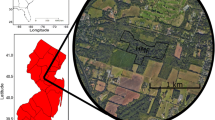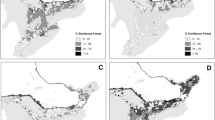Abstract
It is crucial for biodiversity conservation that protected areas are large and effective enough to support viable populations of their original species. We used a point count distance sampling method to estimate population sizes of a range of bird species in three Atlantic forest protected areas of size 5600, 22,500, and 46,050 ha. Population sizes were generally related to reserve area, although in the mid-sized reserve, there were many rare species reflecting a high degree of habitat heterogeneity. The proportions of forest species having estimated populations >500 ranged from 55% of 210 species in the largest reserve to just 25% of 140 species in the smallest reserve. All forest species in the largest reserves had expected populations >100, but in the small reserve, 28% (38 species) had populations <100 individuals. Atlantic forest endemics were no more or less likely to have small populations than widespread species. There are 79 reserves (>1000 ha) in the Atlantic forest lowlands. However, all but three reserves in the north of the region (Espírito Santo and states north) are smaller than 10,000 ha, and we predict serious levels of local extinction from these reserves. Habitat heterogeneity within reserves may promote species richness within them, but it may also be important in determining species loss over time by suppressing populations of individual species. We suggest that most reserves in the region are so small that homogeneity in the habitat/altitude within them is beneficial for maintenance of their (comparatively small) original species compliment. A lack of protection in the north, continued detrimental human activity inside reserves, and our poor knowledge of how well the reserve system protects individual taxa, are crucial considerations in biodiversity management in the region.
Similar content being viewed by others
References
M.A. Alves (2001) Estudos de ecologia de aves na Ilha GrandeRio de Janeiro J. Albuquerque J.R. Cândido SuffixJr. F. Straube A.L. Roos (Eds) Ornitologia e Conservação: da ciência ás estratégias Editora Unisul Santa Catarina Brazil 61–68
G.E. Belovsky (1987) Extinction models and mammalian persistence M.E. Soulé (Eds) Viable Populations for Conservation Cambridge University Press Cambridge 35–57
T. Brooks J. Tobias A. Balmford (1999) ArticleTitleDeforestation and bird extinctions in the Atlantic forest Animal Conserv. 2 211–222 Occurrence Handle10.1017/S1367943099000542
K.S. Brown SuffixJr. C.G. Brown (1992) Habitat alteration and species loss in Brazil T.C. Whitmore J.A. Sayer (Eds) Tropical Deforestation and Species Extinction Chapman and Hall London 119–142
A.G. Bruner R.E. Gullison R.E. Rice G.A.B. Fonseca Particleda (2001) ArticleTitleEffectiveness of parks in protecting tropical biodiversity Science 291 125–128 Occurrence Handle10.1126/science.291.5501.125 Occurrence Handle11141563
S.T. Buckland D.R. Anderson K.P. Burnham J.L. Laake D.L. Borchers L. Thomas (2001) Introduction to Distance Sampling: Estimating Abundance of Biological Populations Oxford University Press Oxford UK
A.G. Chiarello (1999) ArticleTitleEffects of fragmentation of the Atlantic forest on mammal communities in south-eastern Brazil Biol. Conserv. 89 71–82 Occurrence Handle10.1016/S0006-3207(98)00130-X
A. Chiarello (2000) ArticleTitleInfluência da caça ilegal sobre mamíferos e aves das matas de tabuleiros do norte do estado do Espirito Santo Boletim do Museu de Biologia Mello Leitão 11/12 229–247
DeSante D.F. 1981. A field test of the variable circular-plot census technique in a California coastal scrub breeding bird community. In: Ralph C.J. and Scott J.M. (eds), Estimating Numbers of Terrestrial Birds. Studies in Avian Biology No. 6. Cooper Ornithological Society, pp. 177–185.
D.F. DeSante (1986) ArticleTitleA field test of the variable circular-plot censusing method in a Sierran subalpine forest habitat Condor 88 129–142
M.L.B. Fernandes (1997) ArticleTitleUnidades de Conservação do domínio da Mata Atlântica Documentos do Instituto Socio-ambiental (ISA) 4 19–54
G.A.B. da Fonseca (1985) ArticleTitleThe vanishing Brazilian Atlantic forest Biol. Conserv. 34 17–34 Occurrence Handle10.1016/0006-3207(85)90055-2
I.R. Franklin (1980) Evolutionary change in small populations M.E. Soulé B.A. Wilcox (Eds) Conservation Biology: An Evolutionary-Ecological Perspective Sinauer Sunderland 135–150
M. Galetti (2001) ArticleTitleSeasonal movements and diet of the Plumbeous Pigeon (Columba plumbea) in a Brazilian Atlantic forest Melopsittacus 4 39–43
M. Galetti P. Martuscelli F. Olmos A. Aleixo (1997) ArticleTitleEcology and conservation of the Jacutinga Pipile jacutinga in the Atlantic Forest of Brazil Biol. Conserv. 82 31–39 Occurrence Handle10.1016/S0006-3207(97)00004-9
M.E. Gilpin I. Hanski (1991) Metapopulation Dynamics: Empirical and Theoretical Investigations Academic Press San Diego, CA
M.E. Gilpin M.E. Soulé (1986) Minimum viable populations: processes of species extinction M.E. Soulé (Eds) Conservation Biology: The Science of Scarcity and Diversity Sinauer Associates Sunderland MA 19–34
J.M. Goerck (1999) ArticleTitleDistribution of birds along an elevational gradient in the Atlantic forest of Brazil: implications for the conservation of endemic and endangered species Bird Conserv. Int. 9 235–253
V. Grimm I. Storch (2000) ArticleTitleMinimum viable population size of capercaillie Tetrao urogallus: results from a stochastic model Wildlife Biol. 6 219–225
D.B. Gurd T.D. Nudds D.H. Rivard (2001) ArticleTitleConservation of mammals in eastern North American wildlife reserves: how small is too small? Conserv. Biol. 15 1355–1363 Occurrence Handle10.1046/j.1523-1739.2001.00188.x
A.H. Harcourt (2002) ArticleTitleEmpirical estimates of minimum viable population sizes for primates: tens to tens of thousands? Animal Conserv. 5 237–244 Occurrence Handle10.1017/S1367943002002287
O. Howells G. Edwards-Jones (1997) ArticleTitleA feasibility study of reintroducing wild boar Sus scrofa to Scotland: are existing woodlands large enough to support minimum viable populations? Biol. Conserv. 81 77–89 Occurrence Handle10.1016/S0006-3207(96)00134-6
A.P. Kinzig J. Harte (2000) ArticleTitleImplications of endemics–area relationships for estimates of species extinctions Ecology 81 3305–3311
M. Lynch R. Lande (1998) ArticleTitleThe critical effective size for a genetically secure population Animal Conserv. 1 70–72 Occurrence Handle10.1017/S136794309822110X
S.J. Marsden (1998) Counting single species C.J. Bibby M.J. Jones S.J. Marsden (Eds) Expedition Field Techniques: Bird Surveys Birdlife International/Royal Geographical Society London 53–75
S.J. Marsden (1999) ArticleTitleEstimation of parrot and hornbill densities using a point count distance sampling method Ibis 141 377–390
S.J. Marsden M. Whiffin M. Galetti (2001) ArticleTitleBird diversity and abundance in forest fragments and Eucalyptus plantations surrounding a Brazilian Atlantic forest reserve Biodiv. Conserv. 10 737–751 Occurrence Handle10.1023/A:1016669118956
S.J. Marsden M. Whiffin L. Sadgrove P. Guimarães SuffixJr. (2000) ArticleTitleParrot populations and habitat use in and around two lowland Atlantic forest reserves, Brazil Biol. Conserv. 96 209–217 Occurrence Handle10.1016/S0006-3207(00)00071-9
S.J. Marsden M. Whiffin L. Sadgrove P.R. Guimarães SuffixJr. (2004) ArticleTitleBird community composition and species abundance on two inshore islands in the Atlantic forest region of Brazil. Ararajuba 11 29–36
K. Marshall G. Edwards-Jones (1998) ArticleTitleReintroducing capercaillie (Tetrao urogallus) into southern Scotland: identification of minimum viable populations at potential release sites Biodiv. Conserv. 7 275–296 Occurrence Handle10.1023/A:1008844726747
L.P.C. Morellato C.F.B. Haddad (2000) ArticleTitleIntroduction: the Brazilian Atlantic forest Biotropica 32 786–792
T.A. Parker III J.M. Goerck (1997) ArticleTitleThe importance of national parks and biological reserves to bird conservation in the Atlantic forest region of Brazil Ornithol. Monographs 48 527–541
A.T. Peterson L.G. Ball K.W. Brady (2000) ArticleTitleDistribution of the birds of the Philippines: biogeography and conservation priorities Bird Conserv. Int. 10 149–167 Occurrence Handle10.1017/S0959270900000149
S.L. Pimm J.L. Gittleman G.F. McCracken M. Gilpin (1988) ArticleTitleOn the risk of extinction Am. Naturalist 132 757–785 Occurrence Handle10.1086/284889
P. Ranta T. Blom J. Niemela E. Joensuu M. Siitonen (1998) ArticleTitleThe fragmented Atlantic rain forest of Brazil: size shape and distribution of forest fragments Biodiv. Conserv. 7 385–403 Occurrence Handle10.1023/A:1008885813543
K.H. Redford (1989) ArticleTitleMonte Pascoal – indigenous rights and conservation in conflict Oryx 23 33–36
R.T. Reynolds J.M. Scott R.A. Nussbaum (1980) ArticleTitleA variable circular plot method for estimating bird numbers Condor 82 309–313
R.E. Ricklefs I.J. Lovette (1999) ArticleTitleThe roles of island area per se and habitat diversity in the species–area relationships of four Lesser Antillean faunal groups J. Animal Ecol. 68 1142–1160 Occurrence Handle10.1046/j.1365-2656.1999.00358.x
A.S.L. Rodrigues K.J. Gaston (2001) ArticleTitleMaximising phylogenetic diversity in the selection of networks of conservation areas Biol. Conserv. 105 103–111 Occurrence Handle10.1016/S0006-3207(01)00208-7
D.A. Saunders R.J. Hobbs C.R. Margules (1991) ArticleTitleBiological consequences of ecosystem fragmentation: a review Conserv. Biol. 5 18–32 Occurrence Handle10.1111/j.1523-1739.1991.tb00384.x
C.M. Schonewald-Cox (1983) Conclusions: guidelines to management: a beginning attempt C.M. Schonewald-Cox S.M. Chambers B. MacBryde L. Thomas (Eds) Genetics and Conservation: A Reference for Managing Wild Animal and Plant Populations Benjamin/Cummings Menlo Park, CA 414–445
C.H. Sekercioglu P.R. Ehlrich G.C. Daily D. Aygen D. Goehring R.F. Sandi (2002) ArticleTitleDisappearance of insectivorous birds from tropical forest fragments Proc. Natl. Acad. USA 99 263–267 Occurrence Handle10.1073/pnas.012616199
H. Sick (1993) Birds in Brazil: A Natural History Princeton University Press Princeton, NJ
J.M.C. da Silva M. Tabarelli (2000) ArticleTitleTree species impoverishment and the future flora of the Atlantic forest of northeast Brazil Nature 404 72–74 Occurrence Handle10.1038/35003563 Occurrence Handle10716443
I. Simão F.A. Maësdos Santos M. Aurelio Pizo (1997) ArticleTitleVertical stratification and diet of psittacids in a tropical lowland forest of Brazil Ararajuba 5 169–174
A.J. Stattersfield M.J. Crosby A.J. Long D.C. Wege (1998) Endemic Bird Areas of the World: Priorities for Biodiversity Conservation. BirdLife Conservation Series No. 7 BirdLife International Cambridge UK
P.C. Stouffer R.O. Bierregaard SuffixJr. (1995) ArticleTitleUse of Amazonian forest fragments by understory insectivorous birds Ecology 76 2429–2445
J. Terborgh J.S. Weske (1969) ArticleTitleColonisation of secondary habitats by Peruvian birds Ecology 50 765–782
J. Tews U. Brose V. Grimm K. Tielborger M.C. Wichmann M. Schwager F. Jeltsch (2004) ArticleTitleAnimal species diversity driven by habitat heterogeneity/diversity: the importance of keystone structures J. Biogeography 31 79–92
J.M. Thiollay (1994) ArticleTitleStructure density and rarity in an Amazonian rainforest bird community J. Tropical Ecol. 10 449–481
J.A. Tobias N. Seddon (2002) ArticleTitleEstimating population size in the subdesert mesite (Monias bensci): new methods and implications for conservation Biol. Conserv. 108 199–212 Occurrence Handle10.1016/S0006-3207(02)00106-4
T. Tscharntke (1992) ArticleTitleFragmentation of Phragmites habitats, minimum viable population-size habitat suitability, and local extinction of moths, midges, flies, aphids, and birds Conserv. Biol. 6 530–536 Occurrence Handle10.1046/j.1523-1739.1992.06040530.x
D.C. Wege A.J. Long (1995) Key Areas for Threatened Birds in the Neotropics. BirdLife Conservation Series, No. 5 BirdLife International Cambridge, UK
R.B. Wielgus (2002) ArticleTitleMinimum viable population and reserve sizes for naturally regulated grizzly bears in British Columbia Biol. Conserv. 106 381–388 Occurrence Handle10.1016/S0006-3207(01)00265-8
Author information
Authors and Affiliations
Corresponding author
Rights and permissions
About this article
Cite this article
Marsden, S.J., Whiffin, M., Galetti, M. et al. How Well Will Brazil's System of Atlantic Forest Reserves Maintain Viable Bird Populations?. Biodivers Conserv 14, 2835–2853 (2005). https://doi.org/10.1007/s10531-004-0219-9
Received:
Accepted:
Issue Date:
DOI: https://doi.org/10.1007/s10531-004-0219-9




